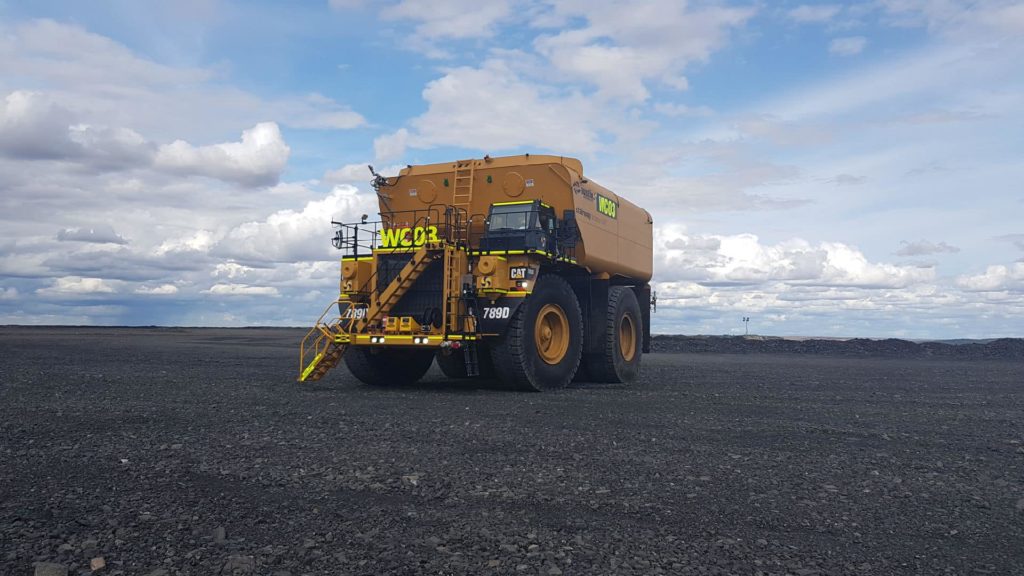Australian Diversified Engineering (ADE) and Austin Engineering have come together to improve dust control and enhance safety at the Glencore-owned McArthur River mine in the Northern Territory of Australia.
ADE’s revolutionary water spray application technology and Austin’s innovative Stairway Access Tank (SAT) are now embedded in two uniquely designed CAT 789 water trucks, which have a 159,000 litre capacity, on site at the operation.
The zinc-lead-silver mine had contracted EPSA to supply and maintain mobile equipment on site and required two new water trucks to be added to its operations, ADE said. Being mindful of improving dust control and ensuring better safety for its workers, it decided to have the trucks specifically designed for the application at hand.
The exclusive design has produced what is now known as the safest water tank in the mining industry, according to ADE. It is an engineering collaboration of which ADE General Manager, Clive Gray, says has set a new bar for water truck technology.
“Controlling airborne dust on mine sites is incredibly important,” he explained. “It minimises the risks to workers, but knowing just how much water to spray has its own challenges and can also become a hazard, leading to unplanned vehicle movement and, even worse, closing a haul road for many hours.
“We have been manufacturing safety equipment for the mining industry for many years but being able to work together with Austin Engineering has allowed us to deliver an exceptional solution for the McArthur River mine. We feel confident that they will see positive outcomes in terms of improved safety and better dust control very quickly, making this a great investment.”
The water truck-based ADE Spray System is a spray control system that consistently sprays a controlled rate of water onto the ground, regardless of speed, to effectively control airborne dust, according to ADE.
Road friction measurements can be used to determine the maximum safe water coverage rate which, in turn, reduces waste and decreases the risk of an unplanned movement. During operations, the system data logs all spray activities which can be used to generate reports and assess operations.
Gray says it is the ability to both measure and monitor that makes the ADE Spray System such a game changer.
“One of the biggest issues for mine sites is knowing how much water to spray on the road,” he said. “Too much or too little have equal repercussions, with safety issues being the greatest concern.
“Mining operators can quickly and easily monitor and track all aspects of their water truck operations using our on-board data logging system, which effectively cuts costs and improves environmental factors in regards to monitoring water usage.
“By eliminating over and under watering, costs, fuel and water usage are naturally reduced, but it is the safety of the mining workers that is at the forefront of our designs.
“By developing and implementing innovative technologies into mines around Australia we limit the risks involved to mining workers, and that is something we are very proud of.”
Austin’s truck-mounted SAT system, meanwhile, includes several features to improve efficiency, operator safety and truck stability, Austin says. The most obvious external feature of the Austin water tank is a stairway from the top of the tank structure down to a large (137 cm x 259 cm) access port for easy entry and exit for personnel and maintenance equipment to the tank interior. The fill port is located behind the water dam to ensure any overflow flows away from the cab and deck to the rear of the truck, Austin says. This helps significantly improve operator safety and comfort inside the tank.
The custom designed CAT 789-based trucks began their journey in Wyoming, USA, where they were initially designed, before then being manufactured in Batam, Indonesia. The trucks were then assembled in Australia by Austin Engineering before ADE engineers installed its latest safety technology, ADE said.
The trucks were then delivered to the mine site where ADE engineers arrived to ensure all components were running as planned before the trucks started their first day of action.











